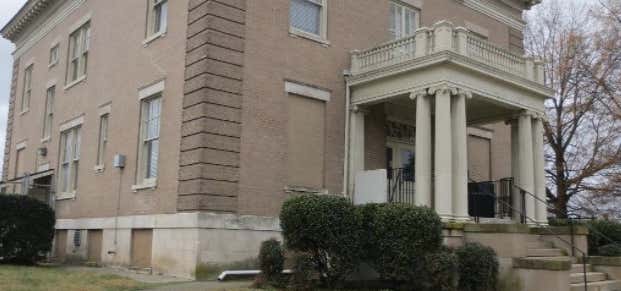“Points of Interest in Richmond, VA”
Several million men took up arms and went to war in the 1860’s. They fell sick in unprecedented numbers, and they died from wounds and disease by the hundreds of thousands. The sudden burden of caring for so many men hit the opposing governments a staggering blow. Hundreds of hospitals sprouted up around the Southern Confederacy, particularly in the capital city of Richmond. The five converging railroads at Richmond, and the city’s proximity to many of the war’s greatest battles, meant that Richmond became a booming hospital center. No medical facility anywhere on the continent during the Civil War equaled the fame and notoriety of Chimborazo Hospital. It quickly emerged early in the war as one of the largest, best-organized, and most sophisticated hospitals in the Confederacy. It took its peculiar name from the hill on which it sat—Chimborazo Hill, on the eastern edge of the city of Richmond. That hill, in turn, was named for Mount Chimborazo, an inactive volcano in Ecuador at nearly 21,000 feet of elevation. Alexander Humboldt had explored Chimborazo earlier in the century and consequently the lofty peak was much better known in the 1800’s than it is today. When the war started volunteer soldiers from around the Confederacy converged on Richmond for organization and drill. Several large regiments camped on and around Chimborazo Hill. They built extensive wooden barracks for shelter. Within a few weeks those soldiers abandoned their quarters and marched to the front lines, then in Northern Virginia. They left behind as many as 100 nearly-new wooden buildings on Chimborazo Hill. The Surgeon General of the Confederate States of America, Dr. Samuel P. Moore, commandeered the buildings for his department and in October 1861 established Chimborazo Hospital. Dr. James B. McCaw, one of the South’s leading young physicians (and a Richmonder) assumed control of the new hospital. He served as its chief for its entire existence. McCaw forged the complex to suit his ideas about how a large military post hospital should function. In due course he had Chimborazo operating like a small city. A staff of surgeons—usually somewhere between 20 and 30 men—watched over an enormous crowd of patients. The corps of men who performed the daily nursing consisted of a large contingent of detailed and disabled soldiers, and many slaves hired from their owners. A few women also served at Chimborazo, usually in the position of matron. They helped feed soldiers, wrote letters for them, administered medicine, organized the kitchens, enforced discipline, and generally tried to be a constant friend to the sick soldiers. On rare occasions the number of patients at Chimborazo approached 4000. For most of the war the majority of the men receiving treatment were sick rather than wounded. Chimborazo was not a field hospital, but rather a convalescent hospital. Most wounded soldiers arriving there from the battlefield had been injured several days earlier, had received emergency treatment soon thereafter, and then went to Chimborazo by railroad or ambulance. Because Richmond never endured a direct attack during the Civil War, Chimborazo operated safely until April 1865. Approximately 75,000 patients passed through its doors over the course of three and a half years. The precise number of deaths is unknown; educated estimates suggest somewhere in the 5000 to 7000 range. Men who died at Chimborazo Hospital nearly always received burial in the Confederate section at Oakwood Cemetery, only one mile northeast of the hospital. When the war ended so too did the useful life of Chimborazo’s wooden buildings. Some of the structures briefly served as a day school operated by the Freedmen’s Bureau, but most of the buildings disappeared very quickly. The local residents, desperate for firewood and recognizing that the hospital belonged to a defunct government, tore most of the old hospital wards down and burned them. The last structure disappeared early in the 1900’s. Since the 1870’s the city of Richmond has operated most of the site of Chimborazo Hospital as a park. Today Richmond National Battlefield Park uses one portion of the hill for its “Chimborazo Medical Museum,” which is housed in a 20th century building atop the site of the historic hospital. Visitors to the museum will learn a great deal more about the famous hospital, about other hospitals in Civil War Richmond, and about the practice of medicine in the 1860’s.
Be the first to add a review to the Chimborazo Hospital National Historic Site.
/-77.4121599469092,37.5268328638117,14/300x172@2x?access_token=pk.eyJ1Ijoicm9hZHRyaXBwZXJzIiwiYSI6ImNsdjQ5N2VtZDA2bW8ycW13ZHAxeGhjbjkifQ.UIccpoAxc7g3BAuK4s9vjg)
Chimborazo Hospital National Historic Site
Hours
Problem with this listing? Let us know.
Has RV parking changed? Let us know.
-
Parking
-
Pets Allowed
-
Restrooms
-
Wifi
-
Wheelchair Accessible
-
Credit Cards Accepted
-
Outdoor Seating
Parking, Dining
Nearby Hotels
Related Trip Guides
The top things to do on a Blue Ridge Parkway road trip
- 85 Places
- 36:11
- 1,293 mi
The top things to do on an I-95 road trip
- 50 Places
- 41:46
- 1,983 mi
The top things to do on an East Coast road trip
- 32 Places
- 48:54
- 2,584 mi
